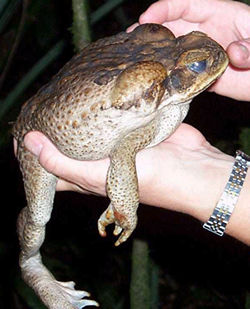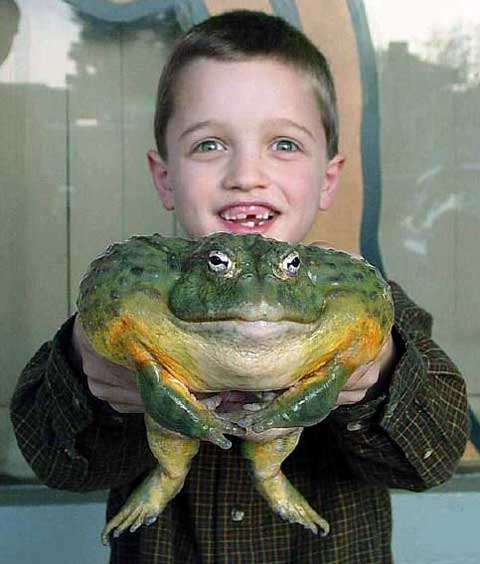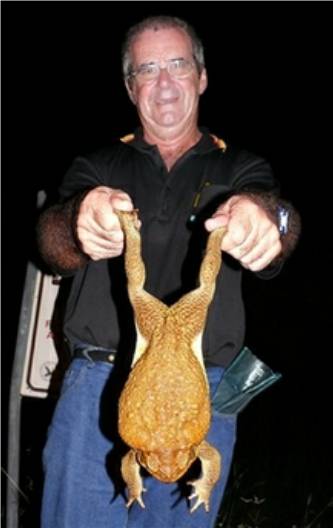The Dreaded Cane Toad
The Unwanted AmphibianSwallow a toad in the morning and you will encounter nothing more disgusting the rest of the day. - Nicolas de Chamfort
An 18cm adult female toad with poison sacs visible Up until 1935, Australia did not have any toad species of it's own. We had tree frogs and ground burrowing frogs - even microhylid frogs which do not have a tadpole - but none of the world's hundreds of toad species evolved here. However, not wanting to be left out, Australia acquired some - 102 toads, in fact. These toads were supposedly being used successfully in the Carribbean islands and in Hawaii to combat the cane beetle, a pest of sugar cane crops. After rave reviews from overseas, Hawaii shipped a box of toads to Gordonvale, just south of Cairns. These were held in captivity for awhile and then they were released into the sugar cane fields of the tropic north. It was later discovered that the toads (scientific name Bufo marinus) can't jump very high (only about 30cm) so they did not eat the cane beetles which stayed up on the upper stalks of the cane plants. At the time of year when the beetle's larvæ were emerging from the ground, no toads were about. So the cane toad, as it came to be known, had no impact on the cane beetles at all and farmers had to go back to the use of chemicals to kill the beetle. Meanwhile, the "cat was out of the bag" or, more accurately, the toads were out of the box! But there were only 102 of them so nobody gave any thought to catching them up again and disposing of them. The toads were on their own and they proved to be very hardy survivors. They turned out to be a lot more than we bargained for and it didn't take long to find out how well the toads would do in their new Australian home.
Fish who eat toadpoles die. Animals who eat young toads and adults die. The museums have plenty of snakes preserved in jars which were killed by toad toxin so fast, the toad is still in their mouths unswallowed. Even small amounts of water which toadpoles have gotten into, such as a pet's water dish, can be poisoned by toadpoles. When the pet comes along to drink from it's dish, it becomes sick. Local vets report that a couple dogs a month are brought in ill just from mouthing toads. Here's a riddle: What happens if you feed a toad too much? Captive cane toads will eat everything from dog food to mice and they keep growing until they reach 25cm in length and over 2 kilos. In recent years, it has been noticed that toads in the Cairns area are much smaller than they used to be. A theory is that when toads first colonise a new territory, there is abundant food supply. The toads gorge themselves and get quite large. As the numbers of toads increase, the food resource never reaches its pre-toad levels and therefore, the toads' size and their food supply acheive a "compromise". Cane toads have proven themselves to be one of Australia's worst environmental disasters. Since 1935, they have spread across most of Queensland, they are over the border into the Northern Territory and they have now reached the world-reknowned wetlands of Kakadu. Their numbers are staggering in the dry southeast Queensland area and they are spreading down the NSW coast. Quite a few have hitched a ride down to Sydney in vegetable trucks and they have established themselves at the 2000 Olympics site (at Homebush Bay in Sydney's inner western suburbs). This area of Sydney is also the largest remaining NSW stronghold for the endangered Green and Golden Bell frog (Litoria aurea). One thing this endangered frog definitely does not need is another threat. Toads are responsible for the reduction of many species of Australian wildlife although "nature finds a way" eventually. Some bird species have somehow learned how to eat cane toads without exposing themselves to the toxin. They kill the toad and turn it over onto its back. They pull away the soft belly skin and partake of the internal organs, leaving the skin and the deadly paratoid glands behind. There is also an Australian snake species called the Keelback or Freshwater snake (Tropidonophis mairi) which is somehow immune to the toad's toxin. Keelbacks swallow and digest entire toads without any ill effect at all. Surely there is important information to be gained from an intense study of the Keelback snake's biology! Source: www.fdrproject.org/pages/toads.htm
Ground "Moves" as Cane Toads Invade ParkSydney - Hundreds of thousands of poisonous baby cane toads invaded an Australian national park Friday, hopping around in such numbers that the ground seemed to move, an ecologist said. The ugly amphibians moved into the Arakwal National Park near one of the country's famous surfing meccas, Byron Bay, following an explosion in toad numbers after recent rains. "You should see the ground down there, it is just black and it is just moving, it is a seething mass of young cane toads," local ecologist Steve Phillips told Australian radio. Park officials plan to destroy as many of the toads as possible before they grow into adults, hoping that once numbers are reduced the threatened wallum froglet and wallum sedge frog populations will pick up. The amphibians - some as big as dinner plates - have now spread out from Queensland west into the Northern Territory and south into New South Wales, threatening the unique Australian fauna in their path. Source: story.news.yahoo.com Friday 19 November
Cane toads actually have a few positive attributes - if you don't believe me, view Cane Toads: An Unnatural History. one of the funniest nature documentaries I've ever seen, available from www.firstrunfeatures.com. Also, see a fantastic short cartoon, Cane Toad: What Happened to Baz in our Animation section. Besides - I've heard that came toads are responsible for reducing the size of snakes in Australia - all the bigger snakes have been killed by eating toads, leaving mostly the smaller snakes that can't quite get a toad into their mouths.
Look What I Found!! Can I Keep Him?
Source: strangezoo.com (By the way, I've been informed that this is an African bullfrog, not a cane toad.)
Australian Toad the Size of a Small Dog
Darwin, Australia - An environmental group said Tuesday it had captured a "monster" toad the size of a small dog. With a body the size of a football and weighing nearly 2 pounds, the toad is among the largest specimens ever captured in Australia, according to Frogwatch coordinator Graeme Sawyer. "It's huge, to put it mildly," he said. "The biggest toads are usually females but this one was a rampant male ... I would hate to meet his big sister." Frogwatch, which is dedicated to wiping out a toxic toad species that has killed countless Australian animals, picked up the 15-inch-long cane toad during a raid on a pond outside the northern city of Darwin late Monday. Cane toads were imported from South America during the 1930s in a failed attempt to control beetles on Australia's northern sugar cane plantations. The poisonous toads have proven fatal to Australia's delicate ecosystems, killing millions of native animals from snakes to the small crocodiles that eat them. As part of its so-called "Toad Buster" project, Frogwatch conducts regular raids on local water holes, blinding the toads with bright lights then scooping them up by the dozen. "We kill them with carbon dioxide gas, stockpile them in a big freezer and then put them through a liquid fertiliser process" that renders the toads nontoxic, Sawyer said. "It turns out to be sensational fertiliser," he added. Source: apnews.myway.com 23 March 2007
"Toad Juice" Buyers Warned Bottles Could Explode Due To FermentationManufacturers of a liquid fertiliser consisting of cane toads say that "toad juice" bottles could explode. Northern Territory FrogWatch, which sold 300 bottles of the juice at Darwin's Garden Spectacular said recently that the liquid inside the batch is still in the process of fermenting and may explode. The company requested customers who have not opened their fresh bottles to turn the caps a little to let some of the pressure out; or else, the may risk getting sprayed with the sticky juice. Graeme Sawyer, of Frog Watch, said the liquid is no longer contains any harmful poison in it. He added, "There's no toxin left in it by the time it's been through the fertilizer process... It's an inert substance in that sense, so there's no problem there... The issue just is that because it was such a fresh batch, it's still producing gas." Sawyer warned, "If you've got it in the bottle and the lid's sealed tightly, it builds up pressure in the bottle." Source: wayodd.com 18 September 2006
Worm May Prove Match for Cane Toad
"It's a pretty exciting set of results", says team leader Professor Rick Shine. "We've known for some time that there is a parasite, a lung-worm, that lives in Australian frogs and they have shifted across to the cane toad. They kill a large number of the small toads that we infected (in the laboratory). The ones that do survive grow less quickly, eat less and generally (the parasites) are a huge problem for the toad." Shine says the parasite is absent from toad populations along the so called 'invasion front', appearing only in those living close to the Queensland coastline. He says this is because uninfected toads move clear of those infected with the parasite, and into uncharted, parasite-free, territory. It may also explain why toads found in the Northern Territory, at the forefront of the expansion, appear larger and fitter. According to Shine, if toads in regions such as the Northern Territory and northern NSW were infected by the parasite, it may be possible to slow their advance quite dramatically. The toad was introduced to Australia in 1935 to control the native cane beetle, but soon became a pest in its own right. Many attempts have been made to control their march across the continent, but they now number more than 200 million, and have spread throughout Queensland and into parts of New South Wales and the Northern Territory. Shine believes the parasite has the potential to reduce toad populations dramatically. But just like the use of myxomatosis and calicivirus on wild rabbits populations in Australia, the effect won't be the magic bullet many are hoping for. "There are evolutionary processes that will occur, which will allow the toad to deal with the challenges it's facing. It's also in the parasite's interest for its host to survive", Shine explains. "I think cane toads are in Australia for a long time, perhaps forever." But before the parasite can be used as a biological control, Shine and his team need to conduct more research to determine what affect it would have on the environment, and then convince government bodies such as Biosecurity Australia it's safe. "We need to find out where this parasite occurs and what effects it has on native fauna, especially native frogs", Shine says. That's why one of the reasons why using a parasite to control the cane toad doesn't excite everyone. Graeme Sawyer, a co-ordinator with the FrogWatch program based in Darwin, is dubious as to whether the use of a biological control would be successful, let alone desirable. "It seems like pie-in-the-sky type talk," says Sawyer. "If it's native then why hasn't it wiped out cane toads in the natural process? If it's not native, I wouldn't like to see it introduced into a new environment." He believes the awareness campaign he helps lead, known as Toad Busters, is having an impact. "We've managed to keep a lid on them and hit them where they might seek refugee", Sawyer says. "This season we've virtually been able to stop them. The numbers at the end of this 'wet season' appear to be less than last year." While the toad is being controlled in urban areas of the Northern Territory, its damaging impact in more remote locations has been extraordinary. A University of Canberra study in 2004 found that the arrival of cane toads in Kakadu National Park reduced yellow spotted monitor numbers by nearly 80% and nearly wiped out the entire population of northern spotted quolls within 12 months. Despite the seemingly gargantuan task that faces toad-busters such as Sawyer, he remains optimistic. "While some people say 'you're wasting your time', the evidence shows that we've had an effect", he says. "If you can beat the main invasion wave the numbers after that aren't as huge." Source: brisbanetimes.com.au AAP 30 April 2007
For more on animals, including reptiles, crustaceans, arachnids, insects, fish, birds, pets, livestock, rodents, bears, primates, whales and Wellington's waterfront, click "Up"
below to take you to the Table of Contents for this Animals section. |
 Animals
Animals Animation
Animation Art of Playing Cards
Art of Playing Cards Drugs
Drugs Education
Education Environment
Environment Flying
Flying History
History Humour
Humour Immigration
Immigration Info/Tech
Info/Tech Intellectual/Entertaining
Intellectual/Entertaining Lifestyles
Lifestyles Men
Men Money/Politics/Law
Money/Politics/Law New Jersey
New Jersey Odds and Oddities
Odds and Oddities Older & Under
Older & Under Photography
Photography Prisons
Prisons Relationships
Relationships Science
Science Social/Cultural
Social/Cultural Terrorism
Terrorism Wellington
Wellington Working
Working Zero Return Investment
Zero Return Investment


 Scientists believe they may have found a chink in the armour of one of Australia's
biggest environmental pests. Sydney University's John Llewelyn and Crystal Kelehear are part of a group known as Team Bufo, named after the despised cane toad, Bufo
marinus. The team has identified a parasitic worm that attacks the toad's lungs, stunting their growth, and in most cases killing them.
Scientists believe they may have found a chink in the armour of one of Australia's
biggest environmental pests. Sydney University's John Llewelyn and Crystal Kelehear are part of a group known as Team Bufo, named after the despised cane toad, Bufo
marinus. The team has identified a parasitic worm that attacks the toad's lungs, stunting their growth, and in most cases killing them.